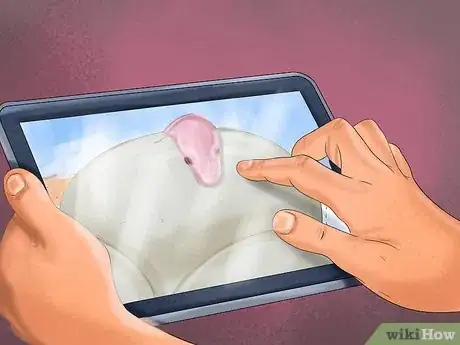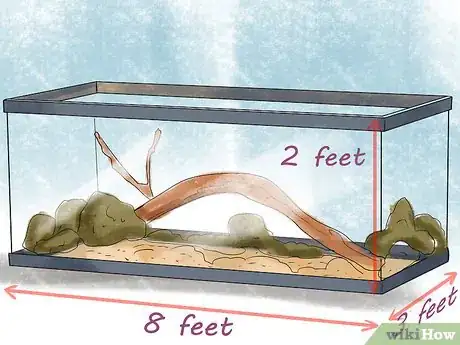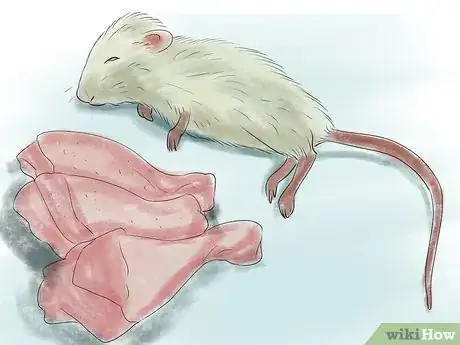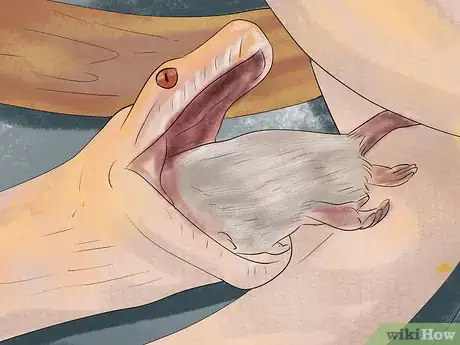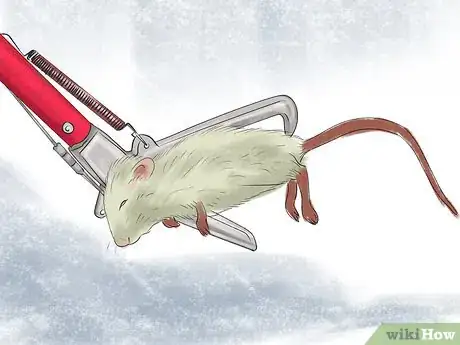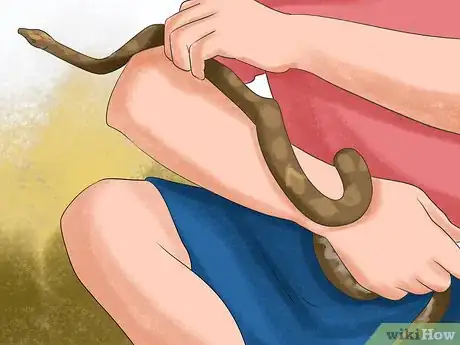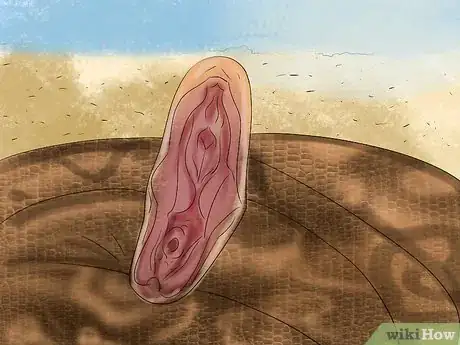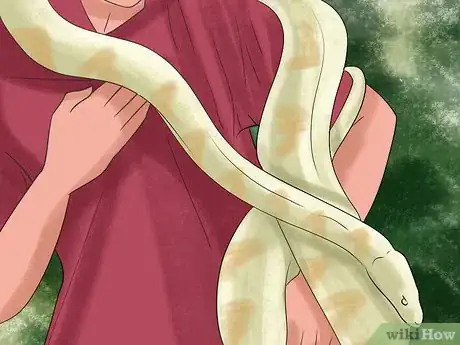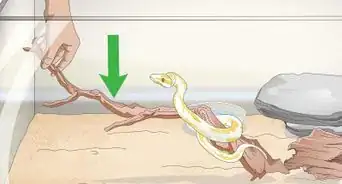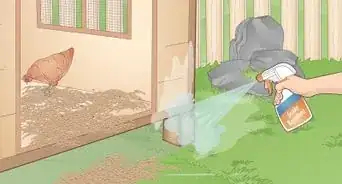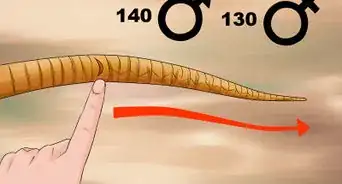This article was co-authored by Pippa Elliott, MRCVS. Dr. Elliott, BVMS, MRCVS is a veterinarian with over 30 years of experience in veterinary surgery and companion animal practice. She graduated from the University of Glasgow in 1987 with a degree in veterinary medicine and surgery. She has worked at the same animal clinic in her hometown for over 20 years.
wikiHow marks an article as reader-approved once it receives enough positive feedback. In this case, 91% of readers who voted found the article helpful, earning it our reader-approved status.
This article has been viewed 23,574 times.
Reticulated pythons, sometimes called “retics,” are large, muscular constrictor snakes. Native to Southeast Asia, a reticulated python requires a lot of space and patience to keep both you and the animal safe and healthy. Though they have a reputation for being aggressive and ill-tempered, reticulated pythons can be quite docile and easy to care for if you are properly prepared.
Steps
Preparing to Get a Reticulated Python
-
1Make sure you have enough room. Reticulated pythons are some of the largest snakes in the world, usually between 10 and 20 feet (300 and 610 cm) long and weighing over 250 pounds (110 kg), with larger ones recorded at 32 feet (980 cm) long and weighing 350 pounds (160 kg). They need floor space amounting to 4 by 8 feet (120 by 240 cm), and if you are not prepared to provide that, your python will not be as happy and healthy as possible.[1]
-
2Find a reputable breeder. When you buy a new python, make sure it comes from a reputable breeder. A well-bred python will be healthy, well-tended to, and bee more temperamentally inclined to captive life. A good breeder will be able to provide detailed information on the python’s size, health, and history, so if you can’t get this, look elsewhere for your snake.[2]
- You can buy wild snakes, but these animals tend to have more parasites and find it more difficult to adjust to a captive environment. Unless you have a specific reason for acquiring a wild python, you are better off getting one from a breeder.
Advertisement -
3Create a large enough environment. Pythons are large snakes, so you cage will need to be at least 2 feet tall by 3 feet wide by 6 to 8 feet long (60 cm tall by 90 cm wide by 180–245 cm long), and should likely be larger. Your snake should have enough room to roam around, but not so large that you can’t effectively control the temperature. It should be made of a strong, waterproof material, which will be easier to clean.[3]
- If you have a baby python, they can survive in smaller areas until they begin to grow. A 10-gallon (45-litres) aquarium is roughly the right size. You may want something other than a glass aquarium, though, as they lack insulation and the ability to hold humidity.
- This cage or environment needs a lock. Pythons are curious and inventive creatures, and they will explore any potential exits from their cage. You do not want your snake getting out on its own, so make sure you have some way to secure those areas.
-
4Provide the proper substrate. Your python will need something comfortable to slither on when it is in the cage. Newspaper and newsprint are good enough, though you can always use soft materials like aspen, cypress mulch, or pre-cut corrugated cardboard. Whatever you put down, make sure you check it daily for waste, and replace it when necessary.[4]
- Make sure there aren’t any corners or sharp objects in the cage. Reticulated pythons can be curious explorers, and will hurt themselves on protruding items.
-
5Create a hiding spot. Pythons aren’t very active, but will want some place they can hide away. It should be cozy and dark, and have an entrance large enough for your snake to enter and exit easily. A small box that the snake can curl up in comfortably should be enough[5]
-
6Vary temperature in the enclosure. Do your best to provide different temperatures in different parts of the environment. Pythons are cold-blooded, so they need different temperatures depending on how they feel. The temperature can range from 76 to 92 degrees Fahrenheit (24 to 33 degrees Celsius), depending on what part of the cage the snake is in.
- To create heat in certain areas, you can install a heat pad or heater under the enclosure floor, or even use heat tape or even a heat lamp. If you use a fixture in the enclosure, make sure it is secure so the snake cannot pull it off.
Feeding Your Python
-
1Provide prey for your snake. Pythons are predators, and need to eat meat. This does not need to be alive, but at least warm. Frozen mice or chicks are available, though you should thaw them in warm water before providing them to your snake.
- Most reticulated pythons will eventually accept frozen or dead food, but occasionally some will not. If that is the case, you need to be prepared to supply live food as long as you have the snake.
-
2Feed the snake regularly. You want your python to have one prey item, about the size of the thickest part of the snake’s body, once every 7 to 10 days. You can space that out to up to 2 weeks between feeding if you are worried about overeating, or gave your python a particularly large meal. Keep a regular feeding schedule, which will help your snake adjust to your presence, and help you keep track of its growth and habits.[6]
- Your snake’s size will be tied to its feeding, meaning the more it eats the bigger it will get. Be careful, as overfeeding can lead to health problems, just like in other animals.
- Reticulated pythons are usually more active in the evening or at night, so this is a good time to offer food.
-
3Use a tool to help encourage feeding. If you are changing your python’s diet, or want to keep a distance when providing food, you can use tongs. When using them, be sure to move the prey in small, slow movements near the python’s head to get its attention. Do not force the feeder into their face, or bump them on the head with it.
-
4Provide a water dish. Your snake will need water, so there should be clean drinking water always available. Put it in a large, easy-to-clean dish, one that can’t be tipped over easily. While your snake may enjoy sitting and soaking in the water, the dish does not need to be big enough for that. Replace the water and clean the dish as necessary.[7]
Caring for Your Snake
-
1Handle your python. Handling your snake can be important for making your python comfortable around you, and gives you the opportunity to show him off to other people. This can also be helpful when you need to interact with your snake, such as during feeding or when you need to check on its health.[8]
- When you pick up the snake, gently get a hold on the upper part of its body, avoiding the head. Make sure you provide support to this part of the body as you pick it up, which will keep your snake calm. Don’t grab the tail or lower part of the body.
- Make sure your snake is awake before you handle it. Pythons are quick to react, and if you startle it while sleeping, it may attack on the presumption you are food. Before going into the cage, tap the glass to get a response so you can know it’s awake.
- Always have at least one other experienced person within earshot when you are handling the python. Pythons are quite strong, and you’ll need the extra hands in case something goes wrong.
- If your snake bites you, one way to get it off quickly is to dump some mouthwash into its mouth. This will tell the snake you aren’t food, and cause it to let go. Reticulated pythons are not poisonous, but if you are bitten you should treat it like any other bite, cleaning and disinfecting the wound.
-
2Take extra precautions during breeding season. Elevated hormone levels during the season can make pythons, especially males, moody and difficult to handle. You may notice male pythons with a reduced appetite, attempting to wrestle with you, or pacing more often around the cage. These are signs that he wants to breed, and he will be a bit high-strung for a while.[9]
- Be careful when handling multiple males during the season. The next snake you interact with may smell the previous male, and react by trying to push you out thinking it is him.
-
3Establish trust by interacting regularly. Reticulated pythons are quite intelligent, and can be taught to trust and respect you once they establish that you are not a threat. The key to establishing this trust is consistent and routine interaction, which allows the python to know you are not a threat. Regular feeding and interaction helps the snake learn to recognize you. This will help make your python easier to work with, and lessen the chance of injury or confrontation.[10]
-
4Watch your snake for pushing. This is a common behavioral problem among reticulated pythons, and one that can lead to further health problems if you don’t watch it. Your snake will regularly push its face against the cage or other object, causing it to swell. In worse cases, it can cause damage to the head, or lead to mouth rot or an abscess. Snakes push because they are uncomfortable, so check out the temperature or humidity in your cage, make sure its hiding spot is secure, or check for other health problems.[11]
-
5Watch your snake’s health. Like any other pet, pythons are susceptible to diseases and other health problems. If you do notice trouble, you can perform some first aid yourself, but you should also consider talking to a vet as well. Reticulated pythons can be the victim of several common health problems, which you should be keeping an eye out for.[12] [13]
- Parasites. Captive snakes, like yours, are susceptible to mites and other external parasites. You can see them crawling on the snake’s skin, either red, black, or white. If you do notice mites, soak the snake in a warm bath for a few hours to let them fall off, then completely clean and disinfect the enclosure.
- Respiratory infections. Pneumonia in particular is common with reticulated pythons, and can be prevented by making sure there is proper heat gradient in the enclosure. If your python is suffering from an infection, you may hear it wheeze when breathing, and it will tend to keep its head elevated. In more advanced stages, you will see a foamy secretion from the snake’s mouth and lower throat. If you see this, contact your vet immediately.
- Inclusion Body Disease (IBD). This is a serious and deadly disease that affects pythons and boa constrictors. Snakes carry the virus, similarly to HIV in humans, and it can cause painful death. A snake with IBD may show signs of neurological problems, like “stargazing” (where the snake twists its head and neck upward to look toward the sky), as well as regurgitating meals or even refusing to eat.[14]
Warnings
- Never allow your snake into the wild, either releasing it intentionally or putting it somewhere that it can escape.⧼thumbs_response⧽
- Don’t let your python loose around other people. If you are showing it to others, make sure someone always has a firm handle on the snake, and that you or another experienced handler are close by.⧼thumbs_response⧽
- Do not keep reticulated pythons together once they are more than 3 feet (91 cm) long, especially males. Snakes can become territorial, especially during breeding season, and will likely fight one another, causing fatal injuries.⧼thumbs_response⧽
References
- ↑ http://www.reptilesmagazine.com/Care-Sheets/Snakes/Reticulated-Python/
- ↑ http://www.reptilesmagazine.com/Care-Sheets/Snakes/Reticulated-Python/
- ↑ http://www.reptilesmagazine.com/Care-Sheets/Snakes/Reticulated-Python/
- ↑ http://www.reptilesmagazine.com/Care-Sheets/Snakes/Reticulated-Python/
- ↑ http://www.reptilesmagazine.com/Care-Sheets/Snakes/Reticulated-Python/
- ↑ http://www.reptilesmagazine.com/Care-Sheets/Snakes/Reticulated-Python/
- ↑ http://www.reptilesmagazine.com/Care-Sheets/Snakes/Reticulated-Python/
- ↑ http://www.reptilesmagazine.com/Reticulated-Python-Mccurley-3/
- ↑ http://www.reptilesmagazine.com/Reticulated-Python-Mccurley-3/
- ↑ http://www.reptilesmagazine.com/Reticulated-Python-Mccurley-3/
- ↑ http://www.petmd.com/reptile/species/reticulated-python
- ↑ http://www.petmd.com/reptile/species/reticulated-python
- ↑ https://pethelpful.com/reptiles-amphibians/Common-Health-Problems-Snakes
- ↑ http://derisilab.ucsf.edu/index.php?news=125
About This Article
When looking after a reticulated python, it's important to gain your snake’s trust by handling it regularly. You can keep your python calm as you handle it by holding the upper part of its body and avoiding its head. Never grab its tail or the lower part of its body. Your snake will also learn to trust you more and become easier to work with if you feed it prey items, like mice or chicks, once every 7 to 10 days. When picking out prey for your snake, avoid animals that are bigger than the thickest part of its body. You should also feed your snake in the evening or night, since its more likely to be active than during the daytime. For more advice from our Veterinary co-author, including how to create a large enough environment for your python, scroll down!

